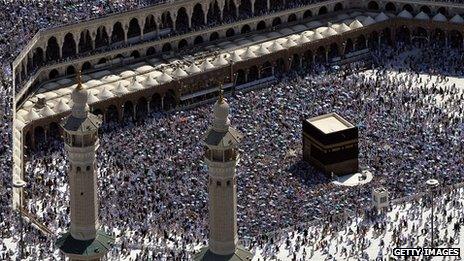Mecca seeks 'green Hajj'
- Published

The Hajj is said to be the largest annual gathering of people in the world.
According to environmentalists, the presence of such a mass of humanity in one place for several days contributes to climate change.
"The vast majority of the pilgrims do not care much about the environment," says Abdel Aziz Sruji, professor of environmental physics in Mecca's Um Al-Qoraa University.
Mecca during the Hajj may have become one of the most polluted cities in the world.
All the waste from food, all the fumes from coaches and cars travelling around the city, all the energy used for powering hotels have a damaging environmental impact.
Mr Sruji is especially critical of the massive use of plastic water bottles by pilgrims.
"They are made of fossil fuels, which highly pollute the environment," he notes, adding that recycling the bottles could produce items like carpets and fleece clothing.

The Hajj generates mounds of unrecycled rubbish
Tens of millions of plastic water bottles do not make their way to the bin. They are dumped all over the streets of Mecca's holy places especially the Arafat area.
'Sustainable Mecca'
Mecca officials face the daunting challenge of how to encourage and enable the three million pilgrims to perform a "green Hajj".
They have decided to help turn Mecca into an environmentally sustainable city.
Mecca Mayor Osama al-Bar says he wants to make mosques in the area "eco-friendly".
"We have invited international bidders to build a gigantic solar power station, which will be used in illuminating mosques, hotels, streets and tunnels across Mecca," he explained.
Mr al-Bar said an underground system was being planned to serve the entire city, with 120km (75 miles) of track and up to 28 stations.
The system will help solve the chronic problem of traffic congestion in Mecca during the Hajj.
Last year, a monorail worked with full capacity to transfer up to 500,000 pilgrims between three holy places they must visit as part of the rituals.
But the concept of public transport has not taken root so far in Saudi Arabia.
Environmentalists like Dr Sruji say cheap petrol and a Saudi preference for large cars have discouraged the authorities from building a network.
Reduced footprint
Mr Sruji is concerned about the number of times that people do the Hajj - which should be carried out by Muslims at least once in their lifetime provided that they are financially and physically able.
"Most of the pilgrims use aeroplanes to come to Saudi Arabia," he said.
"Aviation has a disastrous effect on the environment. Muslims should follow in the footsteps of the Prophet who performed Hajj just once in his lifetime.
"Just think about the damage that can be done to the ozone layer by aeroplanes," he said.
The layer shields the entire Earth from much of the harmful ultraviolet radiation that comes from the Sun.
One Muslim made the trip this year from Bosnia-Hercegovina to Mecca in an entirely environment-friendly way - on foot.
With a just a backpack, Senad Hadzic, 47, left his home last December and had covered about 5,700km (3,500 miles) in 314 days of walking through several countries until he reached Saudi Arabia.
In 2010, two young South African Muslims cycled almost 11,000km (5,800 miles) over the course of nine months to perform the Hajj.
Mr Sruji has two simple sustainable solutions to Mecca - banning cars from specific routes and distributing recycling bins across the city.
However, he laments, "climate change is not a high priority" for pilgrims.
- Published25 October 2012
- Published22 October 2012
- Published21 November 2011